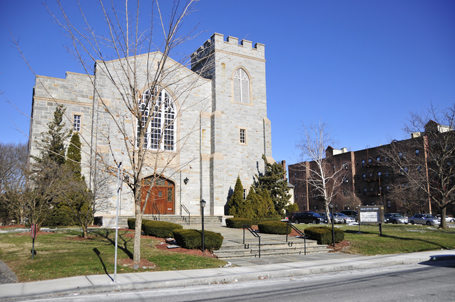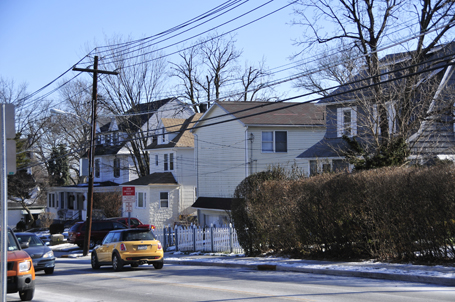
Lincoln School Desegregation Today (Part IV): Civil Disobedience
| Paul Zuber with families walking to Ward School with lawn chairs. Life Magazine, May 6, 1966, p. 100 |
Lincoln School Desegregation Today: Part I - Early Gerrymandering
Lincoln School Desegregation Today: Part II - The Dodson Report
Lincoln School Desegregation Today: Part III - Frustration Grows
Civil Disobedience
Hallie Taylor, mother of two Lincoln students, was a high school graduate and the wife of a postal employee. She was one of the parents who led the New Rochelle protests. She felt that her children they were not achieving their potential and wanted them to attend an integrated school. She began to take action.
"On September 14th, (1960) a week after classes had started, the parents of twelve black children - ages five through ten- showed up in the principal's office of the brand-new Ward School in Quaker Ridge. Their choice of targets was calculated: the Ward School was modern, light, and airy, and on spacious grounds, unlike the crumbling, cramped Lincoln School." (Sweet Land of Liberty, by Thomas J. Sugrue, page 193)
School Superintendent Herbert Clish, did not expect the parents to boldly try to register their children at Ward. The story goes that he was interrupted while shaving with the news. He rushed to Ward and tried to tell the parents that Lincoln School was just as good as Ward school. He failed to see at all what the parents were trying to communicate.
In Sweet Land of Liberty author Sugrue writes "He rebuffed the parents and insisted that the Lincoln School was every bit as good as Quaker Ridge (Throughout the ensuing court battle, Clish would maintain that position, arguing that there were no significant differences in the quality of education between the town's wealthy white-dominated schools and its poorer majority-black ones.) The parents were out of line, Clish contended, … sticking to its policy of neighborhood schools."
 |
| Lincoln Park |
There is a truly surprising photograph of Dr. Barbara T. Mason, the principal of Roosevelt Elementary telling the parents that the district rules require their children to go to the schools near their home. The principal is African American. The photograph appears above the article "Negro Principal Rebuffs Negroes" from the NY Times, September 16th, 1960. Dr. Barbara T. Mason later was one of two principals that had to testify before Federal District Judge Kaufman. (NY Times article "Race Criteria Irk Negro Educator", November 30, 1960) It is also interesting to note that there was at least one Negro member of the school board, Mrs. Maralynn G. Pierce.
In a September 20th, 1960 New York Times covered the event in an article entitled "New Rochelle Firm - School Ban on Shifting Pupils Stands, Despite Negro Pleas". The article said "Four mothers from the Lincoln District, who said they represented fifty Negro children being tutored privately rather than attend Lincoln classrooms, applied today at the Barnard, Mayflower, and Webster Schools. They asked specifically to enroll thirteen children who accompanied (them)". The article went on "In each instance the school principal refused the enrollments because the school board has ruled that pupils must attend schools in the districts where they live. The mothers plan a sit-in strike at the William B Ward School on Wednesday."
A group of black mothers continued to try to enroll their children in other schools throughout New Rochelle. They were rejected at each school. The parents were getting angrier, but were buoyed by the support they began to receive. The media began to take an interest.
 |
| Church on Lincoln Ave. located just out of Lincoln District |
"On September 22nd, the NAACP's Reverend M. DeWitt Bullock led seven parents to the grounds of the Ward School, armed with folding chairs. They presented their demands, the gathered in prayer, and when the police approached they walked into the school, unfolded their chairs, and calmly awaited their arrests for loitering." (Sweet Land of Liberty, by Thomas J. Sugrue, page 194) The moms did not give up, one week later four marched on Roosevelt school with their children and were served a court order denying them the right to school grounds. At Roosevelt School opposite Wykagyl Country Club "The only Negro pupils there are the six children of Alex Quaison-Sackey of Ghana and Nathan Barnes of Liberia, who live near the school and are permanent delegates to the United Nations". (NY Times, "Negroes Sitdown Balked at School" Sept. 27, 1960)
The superintendent insisted that the schools were not segregated. There was only one high school and it was fully integrated and the two junior high schools were integrated. He continued to promote the neighborhood school policy as legal and the school district was not responsible for who decided to live where. Clish also told the parents that they misunderstood the Brown decision. He insisted that the lines of the school district were created without consideration of the races of the people that live within the districts. He felt that the government should not interfere in the housing patterns of society. He even thought that sending the Lincoln children to the white schools would be disadvantageous to them.
 |
| Houses on Lincoln Avenue |
On October 21st, Paul Zuber filed a lawsuit against the New Rochelle school district on behalf of Hallie Taylor's eight year old daughter Leslie and other children. My next post will discuss the trial.
Lincoln School Desegregation Today (Part V): The Trial, Plaintiff's Case